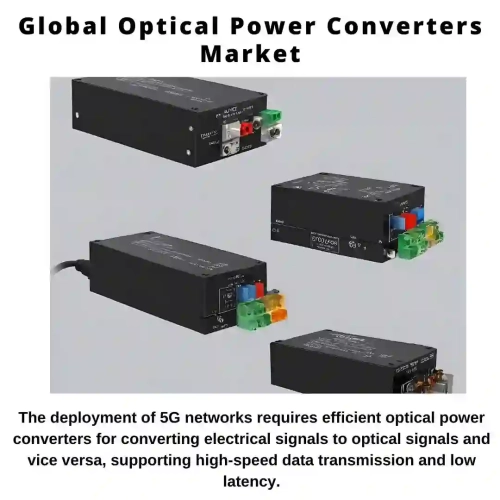
- Get in Touch with Us

Last Updated: Apr 25, 2025 | Study Period: 2024-2030
The optical power converters market is a dynamic segment within the broader field of optical technology, primarily driven by the increasing demand for high-speed data transmission and communication networks. Optical power converters play a crucial role in converting optical signals into electrical signals and vice versa, enabling seamless integration between optical fiber networks and electronic systems.
The market has witnessed significant growth in recent years, propelled by the rapid expansion of data centers, telecommunications infrastructure, and the adoption of optical networking technologies in various industries. Advancements in photonics technology, such as the development of efficient and compact optical-to-electrical and electrical-to-optical converters, are further driving market growth by improving data transmission speeds, reducing power consumption, and enhancing system reliability.
Moreover, the proliferation of 5G networks, Internet of Things (IoT) devices, cloud computing, and streaming services is fueling the demand for high-bandwidth optical communication solutions, thereby driving the adoption of optical power converters.
Additionally, the market is characterized by ongoing research and development activities aimed at enhancing the performance and efficiency of optical power conversion systems, including innovations in materials, design architectures, and manufacturing processes. With increasing investments in infrastructure development and the continuous evolution of communication technologies, the optical power converters market is poised for sustained growth and innovation in the coming years.
Optical Power Converters (OPCs), also known as Laser Power Converters (LPCs), have emerged as crucial devices in the field of power electronics and optical power transmission. These converters play a vital role in converting optical power, whether from sunlight or laser sources, into electrical power for a wide range of applications.
The development of OPCs has seen significant advancements in recent years, with a focus on enhancing efficiency, output power capabilities, and reliability. OPCs are utilized in power links, radio-over-fiber systems, long-distance laser power beaming, and various other applications where the conversion of optical power to electrical power is essential.
The evolution of OPCs has led to the introduction of multijunction devices that offer improved performance and efficiency compared to single-junction converters. These multijunction OPCs are designed to operate at different power levels, categorized as regular-power, medium-power, and high-power devices based on their output power capabilities. The research and development activities in the field of OPCs continue to expand, aiming to enhance device performance, efficiency, and deployment in diverse applications.
Overall, Optical Power Converters represent a critical technology that bridges the gap between optical and electrical power systems, enabling efficient power conversion and transmission across various industries and applications.

The Global Optical Power Converters market accounted for $XX Billion in 2023 and is anticipated to reach $XX Billion by 2030, registering a CAGR of XX% from 2024 to 2030.
The Optical Power Converters Market is witnessing significant trends driven by the burgeoning demand for high-speed data transmission, particularly in telecommunications and data center applications. One prominent trend is the shift towards higher power densities and increased efficiency in optical power converters.
As data traffic continues to surge, driven by factors like cloud computing, streaming services, and the Internet of Things (IoT), there's a growing need for optical power converters that can handle higher power levels while minimizing energy consumption and heat dissipation. This trend is pushing manufacturers to develop innovative solutions such as advanced semiconductor materials, novel packaging techniques, and intelligent power management algorithms to meet the evolving demands of the market.
Additionally, the Optical Power Converters Market is experiencing a trend towards miniaturization and integration, driven by the proliferation of compact and mobile devices as well as the deployment of optical networking solutions in space-constrained environments. Integrating multiple functions into a single device, such as combining optical power conversion with signal conditioning or data processing capabilities, enables more efficient and cost-effective optical systems.
This trend towards integration is fueled by advancements in semiconductor technology, packaging techniques, and system-on-chip (SoC) design methodologies, allowing manufacturers to deliver compact and highly integrated optical power converter solutions that meet the stringent requirements of modern communication networks and consumer electronics applications.
In recent years, key advancements have been demonstrated in Optical Power Converters (OPCs) for power links and radio-over-fiber, long-distance and safe laser power beaming, power electronics, and other applications. Research has shown that the required high conversion efficiencies are best achieved using a multi-junction VEHSA design.
For output powers below 1 W, the OPC devices can be tailored to output voltages ranging from 4 V to 30 V with conversion efficiencies up to >60%. Many companies have been selling the 4 V and 6 V OPCs as for a few years and is now expanding its offer with equivalent devices in the form-factor of âmedium-powerâ (optical input power, Pin < 6 W) and âhigh-powerâ (Pin < 50 W).
Given the clear benefits of the multijunction OPC devices, they are quickly taking over their single junction predecessors in field applications requiring total galvanic and EMI isolation for power transmission. The key advancements achieved with the above OPC devices are expected to expand the deployment of power-over-fiber applications. Global research activities in the field of OPC and related photovoltaic devices continue to flourish and pave the way for further device improvements
Optical power converters enable new and promising power-over-fiber or power-beaming applications. Research has exemplified opportunities for various power options. Stable and reliable DC electrical outputs have been demonstrated with record efficiencies and for output power of up to Pmpp = 40 W. Research has shown the various options currently available and the ongoing device developments for the 800â830 nm, 960â990 nm, and 1500â1600 nm spectral ranges.
These high-efficiency multi-junction designs enable practical optimal loads and tailored output voltages. Additional improvements of the optical to electrical conversion efficiencies are possible in future studies by further optimizing the heterostructure design to the various optical spectrums of interest.
For example, this can be achieved by extracting more precisely the optical constants of the absorber material and by quantifying more accurately the impact of photon coupling and recycling in the different subcells. Higher OPC efficiencies can also be readily achieved by minimizing the thermalization losses by reducing the energy difference between the photons of the optical input and the absorber bandgap.

By Fiber optic connectors:
| Sl no | Topic |
| 1 | Market Segmentation |
| 2 | Scope of the report |
| 3 | Research Methodology |
| 4 | Executive Summary |
| 5 | Introduction |
| 6 | 5 Key Predictions for Global Optical Power Converters Market |
| 7 | Insights from Industry stakeholders |
| 8 | Cost breakdown of Product by sub-components and average profit margin |
| 9 | Average B-2-B selling price in past 5 years |
| 10 | New product development in past 12 months |
| 11 | Expansion and Applications of the Global Optical Power Converters |
| 12 | Importance of Technological innovation |
| 13 | Research Focus Area for Optical Power Converters |
| 14 | Market Size, Dynamics and Forecast by Fiber optic connectors, 2024-2030 |
| 15 | Market Size, Dynamics and Forecast by End-use industry, 2024-2030 |
| 16 | Market Size, Dynamics and Forecast by Type, 2024-2030 |
| 17 | Market Size, Dynamics and Forecast by Geography, 2024-2030 |
| 18 | Market Size, Dynamics and Forecast by Technology, 2024-2030 |
| 19 | Competitive Landscape |
| 20 | Gross margin and average profitability of suppliers |
| 21 | M&A in past 12 months |
| 22 | Growth strategy of leading players |
| 23 | Market share of vendors, |
| 24 | Company Profiles |
| 25 | Unmet needs and opportunity for new suppliers |
| 26 | Conclusion |